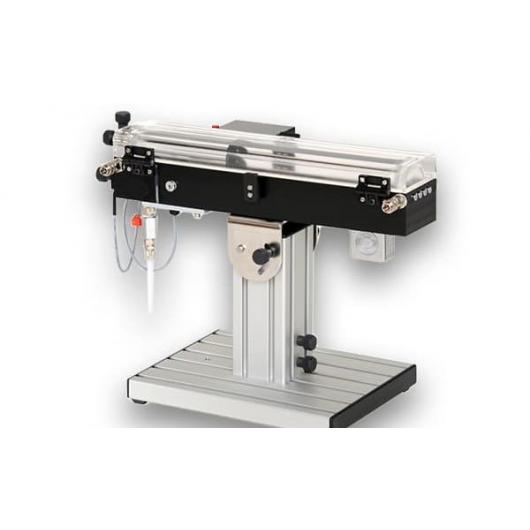
CaloSys, indirect calorimetry
Features
- PULL and PUSH mode (for conventional or hypoxia/isocage studies)
- Continuous or multiplexed sampling
- Optional high-speed gas sensors for accelerated multiplexed measurement
- Auto-calibration ensures consistent sensor accuracy prior to experiment
- Elimination of variable influence of water by a first pass physical Peltier-based gas drying unit
- Gas analyzer expandable with p, Cp and VOC sensors
Application
- Indirect Calorimetry
Module of
The TSE Systems Indirect Gas Calorimetry module measures the animal’s oxygen consumption and carbon dioxide production to calculate key metabolic parameters, including the respiratory exchange rate (RER), and energy expenditure (EE). Specialized isotope sensors such as for 13C can be used for substrate utilization (fat vs. carbohydrate catabolism).
The optional new ClimateBoard module adds continuous temperature and humidity environment monitoring to the home cage. This allows for accurate animal welfare monitoring and future refinement in co-housed animal studies and moving to a “direct calorimetry” application. And, in combination with the new optional InfraMot module can be extended to include continuous movement monitoring.
Phenomaster offers several versions of gas sensor configurations that differ in time resolution and speed of measurement. In the economical high-speed Multiplex mode where several cages share a sensor pair for O2 and CO2, we use a combination of a new (MOPO) magneto-optical paramagnetic oxygen sensor with a T90 of 1.3 seconds and a new (NDIR) optimized optical near-infrared CO2 photometer detector with a T90 of 2.5 seconds. Both are nearly drift-free (less than 1% per week of sensor range) and maintenance-free. The NDIR can be optionally further configured to simultaneously also provide 13C isotope and Cp methane data. Together this combination can detect changes in O2 and CO2 in the low ppm range at flow rates between 0.34 to 100 L/minute with a measurement time of 15 seconds per cage to reach 99% of the final signal. Importantly this measurement speed does not depend on the number of cages in the system. Taken together with the programmable flow rate, “cage time constants” can be chosen to optimize the signal to noise based on the application. For example, the effect of a dietary intervention is easily satisfied with a lower cage time constant compared to an exercise-based cardiometabolic challenge routine. Flexibility is key to match the measurement to the application under the optimal condition yielding maximal accuracy of the measurement. The software provides cues to the user to optimize the cage settings.
The native speed of the sensors used in Phenomaster is so high in hardware that we do not need to resort to transfer functions to mathematically speed-up sensor signals or resort to Z-transformation to interpolate and create data points with time constants multiple times faster than the actual time resolution of the gas sensors. Real data, measured.
CaloSys is a fully automated high-throughput module for short- and long-term metabolic experiments. While conventional systems use standard PULL mode only, TSE’s CaloSys offers the most flexibility with both PULL and PUSH mode continuous and multiplexed respirometry. Only PUSH mode permits hypoxia studies, experiments under germ-free conditions and exposure to a defined gas composition.
Choose between CONTINUOUS high-speed measurements for unparalleled time resolution or MULTIPLEXED calorimetry with sharing of gas sensors between two or more cages. Additional sensors can be added at any time. Take advantage from the advanced technology solutions including programmable mass flow controllers for optimized flow rates in every cage, high-precision gas sensors, clean physical (instead of chemical or calculated) elimination of variable water vapor influence and convenient auto-calibration. CaloSys provides raw sensor data and calculation formulas directly available and accessible, thus granting unique transparency and adaptability. Data are shown and can be accessed immediately during the experiment.
CaloSys can be used with a home cage setup equipped with enrichment tools granting maximal animal welfare in various combinations of options and modules. CaloSys can also be coupled into a treadmill (CaloTreadmill) or wheel (CaloWheel) for exercise calorimetry, or into a special cage construct designed for urine and feces quantification (Metabolic PhenoCage).
Kunath, A., Weiner, J., Krause, K., Rehders, M., Pejkovska, A., Gericke, M., Biniossek, M.L., Dommel, S., Kern, M., Ribas-Latre, A. and Schilling. Role of Kallikrein 7 in Body Weight and Fat Mass Regulation. Biomedicines 2021; 9(2): 131.
Hingst, J. R., Kjøbsted, R., Birk, J. B., Jørgensen, N. O., Larsen, M. R., Kido, K., ... & Wojtaszewski, J. F. Inducible deletion of skeletal muscle AMPKα reveals that AMPK is required for nucleotide balance but dispensable for muscle glucose uptake and fat oxidation during exercise. Mol Metabol 2020; 40: 101028
Kim, S. J., Jeong, Y. T., Jeong, S. R., Park, M., Go, H. S., Kim, M. Y., ... & Moon, S. J. Neural regulation of energy and bone homeostasis by the synaptic adhesion molecule Calsyntenin-3. Experimental & molecular medicine. 2020; 52(5): 793-803.
Fernández-Calleja JMS, Bouwman LMS, Swarts HJM, Oosting A, Keijer J, van Schothorst EM. Extended indirect calorimetry with isotopic CO2 sensors for prolonged and continuous quantification of exogenous vs. total substrate oxidation in mice. Sci Rep 2019; 9(1): 11507.

